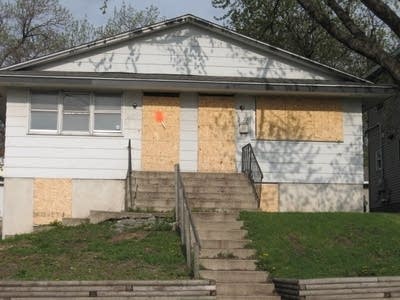Homeowners in Minn. expect to benefit from Obama foreclosure plan
Go Deeper.
Create an account or log in to save stories.
Like this?
Thanks for liking this story! We have added it to a list of your favorite stories.

Kristin Brown of Richfield is trying to squeeze every detail she can out of the Obama foreclosure solution plan.
Does she think it will help her?
"I do," she says.
Brown is probably underwater, the term being used to explain she owes more on her mortgage than her house is worth.
Turn Up Your Support
MPR News helps you turn down the noise and build shared understanding. Turn up your support for this public resource and keep trusted journalism accessible to all.
Brown and her husband owe $228,000.
"I've got a market value from property taxes listing it a $228,000. But I see homes on my block going in the short sale direction for $150,000," she says.
A feature of the Obama plan is homeowners too far underwater won't qualify, so Kristin Brown says she needs to know the exact value of her home, a challenge given current market conditions.
"We won't know that until we have appraisers come out and (determine) where is the floor (for her house) and...where is the floor in the housing market."
Foreclosure expert Prentiss Cox is also waiting to learn more details about the Obama plan.
His reaction to the announcement Wednesday?
"Finally," he says.
Prentiss Cox is a University of Minnesota law school professor and well known for his work as a former assistant state attorney general.
Cox co-authored language for laws now on the books reining in and otherwise trying to address a range of financial skullduggery by lenders and others.
Cox for years was among those warning this country's home mortgage meltdown rooted in subprime lending was going to be more severe and wide ranging in its consequences than many at the time thought.
It's not clear the Obama plan requires lenders to refinance homeowners who are in trouble, Cox says.
"But there is also a provision here suggesting that there will be required participation by lenders who accept money from the government as part of the bailout," he says.
One tool missing from the plan that would help distressed homeowners who are in bankruptcy is 'cram-down,' Cox says.
For a home mortgage, a cram-down is where the bank agrees the home is worth less, agrees to take a loss on the mortgage, strikes a new deal with the homeowner for a lower mortgage amount.
However, Cox says, the Obama administration is telling Congress to change bankruptcy laws and give homeowners a chance to use the technique now available to business and investors.
It's too early to tell how many Minnesotan's will be helped by the Obama plan. State officials say more than 27,000 homes were foreclosed last year. Estimates vary but housing experts predict the number this year could be as large.
There would have been many fewer, Cox argues, if a bill passed by Minnesota lawmakers last session deferring new foreclosures had not been vetoed by Gov. Pawlenty.
"This is exactly why we passed that foreclosure deferment bill so we could get those homeowners to the day when there was a comprehensive federal solution and not just kick them out because no one was doing anything in 2008," he says.
Many big banks including Wells Fargo, the country's largest issuer of home mortgages, had suspended foreclosures as they waited for President Obama to unveil his plan.
Wells Fargo declined to be interviewed and issued a statement saying the bank, "supports the spirit of the administration's mortgage refinancing and foreclosure prevention plan and is working closely with the Administration to put it into action".
Kristin Brown, who is in her mid-50s, retired and disabled, and her husband, who is also retired and disabled, got into deep financial trouble because of serious medical problems.
They refinanced to take cash out of their house and pay medical bills.
They're hanging on, Brown says, glad for the Obama announcement after watching other sectors of the economy getting attention.
"I mean, we've bailed out the banks, the car manufacturers and Wall Street and I was concerned that people like us would not be assisted," she says.
Still unknown is how many people here in Minnesota and elsewhere will actually be assisted.
Dear reader,
Political debates with family or friends can get heated. But what if there was a way to handle them better?
You can learn how to have civil political conversations with our new e-book!
Download our free e-book, Talking Sense: Have Hard Political Conversations, Better, and learn how to talk without the tension.




